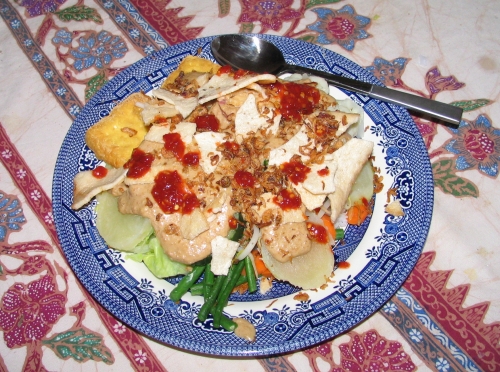
Indonesians eat a lot of their foods with their hands, but not usually Gado-Gado (I'm sure there are exceptions). You might be tempted to break out a fork for the task but a spoon the size of a serving spoon is more common and authentic.
Before eating Indonesians often say Makanlah (Ma Con Lah) which means "Let's Eat!" This exhortation is often accompanied by a symbolic motion by the speakers hand "offering" the food to others. This is particularly done when eating in public, the offer is extended to everyone nearby the eater, not just the folks at the table.
When eating in an informal Indonesian restaurant it is not uncommon for strangers to sit down to eat with you if your table has any empty chairs. It's a great way to meet new people!
Gado-gado an Indonesian Culinary Adventure
Gado-gado is a popular Indonesian dish that hails from the island of Java but is found throughout much of Indonesia and Malaysia. Like many Indonesian meals -- and gado gado is a complete meal -- it creates a melody of tastes; at once spicy hot, sour, sweet and very slightly salty. The ingredients vary from place to place and from cook to cook. Typically it is served at room temperature but it is best if everything is freshly prepared and still slightly warm but not hot. The word Gado-Gado simply means "mixed-up."
If you are a vegetarian traveling to Indonesia, it will be a culinary refuge. Done right, gado-gado is a multi-layered delight. The lowest layer consists of freshly cooked white rice. On top of this are cooked vegetables, hard boiled eggs and fried tofu. Toping this is a layer of spicy peanut sauce. The top layer consists of a prepared tomato and chili sauce along with fried onions and shrimp crackers.. We give a recipe for making "home-made" peanut sauce but dry pre-prepared mixtures can be purchased and they are gaining in popularity. All of the ingredients mentioned in this article can be purchased in the 99 Ranch Market on Clairmont Mesa Blvd.
Gado-gado Peanut Sauce (Bumbu Kacang )
The peanut sauce for Gado-gado is a bit difficult to make here in the United States due to unavailability of certain spices and flavorings in American stores, even in Asian grocery stores. You may be tempted to purchase ready-made peanut sauce, often called "Thai peanut sauce" found in many American and Asian grocery stores but we have not found any that come close to the Indonesian style.
There is, however, a very reasonable and tasty alternative. At 99 Ranch Market on Clairemont Mesa Blvd. you can purchase little ready-made packages of ground peanuts and spices that will do just fine. The are called Bumbu Gado-gado or Bumbu Pecel This peanut sauce can also used for Javanese-style "sate" skewers of chicken and sometimes beef or goat that are marinated in a sweet soy sauce (kecap manis.
You can follow the package instructions which suggest just adding water. For a tastier and creamier sauce, substitute coconut milk for the water and add a tablespoon or two of fresh lime juice at the very end. If you desire a more spicy-hot sauce, add a tablespoon or two of "Sambal Olek" a hot chili-tomato-garlic sauce which can now be found in nearly all San Diego grocery stores in the Asian food section.
If you really must make your peanut sauce from scratch here is a recipe.
Peanut Sauce Ingredients
- 1/2 tablespoon of peanut oil
- 1 cup of natural peanut butter (not chunky)
- 2 cloves of finely chopped garlic
- 1/2 teaspoon of shrimp paste (terasi or blacan. but 1 Tbsp of fish sauce can be used instead)
- 1 cup of coconut milk (water can be substituted but you will lose a bit of flavor and delectable creaminess)
- 2 tablespoons minced shallots
- 1 tablespoon of soy sauce
- 1 cup of water (that would be 2 cups if you are not using the coconut milk. Amusingly the Indonesian word for water is air, roughly pronounced "ah-ear")
- 3 tablespoons of palm sugar (aka gula jawa, gula merah or jaggary) brown sugar can be substituted).
- 1 teaspoon of sambal olek
- 2 tablespoon tamarind juice (lemon or lime juice are fine too)
- 1 tablespoon ground Kencur root (aka "lesser galangal")
- 3 citrus leaves (kaffir lime or jeruk perut)
Note: It may be easier to use sweet soy sauce "Kecup Manis than the soy sauce and palm sugar found in this recipe. Use this to sweeten the sauce to taste, it should be fairly sweet but not overbearingly.
For a glossary of popular Indonesian ingredients see: http://www.melroseflowers.com/mkic/ingredients.html
Peanut Sauce Preparation:
- Heat the oil in a frying pan over a medium heat.
- Add the garlic and shrimp paste and cook for 1 minute stirring constantly to dissolve the shrimp paste.
- Add all of the remaining ingredients except the tamarind juice (or lemon or lime juice).
- Bring to a boil then reduce heat to low and simmer uncovered for 10 to 15 minutes. Be sure to stir frequently to prevent the sauce from burning.
- When sauce is creamy add in the tamarind, lemon or lime juice.
If the sauce gets too thick just add more water. It should be rather thick but pour easily.
Essential Ingredients! Bumbu Pecel, Krupuk Udang and Sambal Olek
Main Ingredients:
You can use practically any kind of vegetable you can think of, below are ones that might be more popular in Indonesia. You can use more or less of the vegetable according to your liking, we mention 1 cup amounts but this is really up to you and the desires of your guests. Do not overcook the vegetables; they should be just past the point of being crunchy. All the vegetables can be cooked in salted water.
- 3-4 hard boiled eggs, peeled and sliced (A trick for cooking hard-boiled eggs is to bring them to a boil, cover the pot, turn off the heat and wait 20 minutes)
- 1 cup cabbage, cut into medium size bits
- 1 cup long beans cut into 4inch lengths (these are called kacang panjang in Indonesia, also known as "Chinese long beans." Trim the ends and cut into 4-5 inch lengths. It is perfectly ok to substitute whole green beans instead).
- 1 cup carrots, sliced
- 1 cup cauliflower, cut into smallish bud sized pieces
- 1 cup mung bean sprouts
- 1 medium sized boiled, peeled and sliced potato
Preparation:
Attention to cooking times is essential for an outstanding result. At sea level we suggest:
- Boil the potatoes until they are done but not mushy. You can boil the whole, pre-sliced or however you like.
- 3-4 minutes for the carrots
- 2-3 minutes for everything else
- Cucumbers. Use raw. Score the cucumber lengthwise with a fork before slices, we swear it improves their taste (and, of course they look nicer).
- Tomatoes: Use raw, cut into small wedges.
Frying the Tofu
This is a bit more tricky that it might seem as tofu has so much water in it making it difficult to brown. Chinese and Japanese fried tofu is covered with flour or cornstarch, but this is not very Indonesian tasting. Start out by slicing the tofu into flat strips. It is important that you pat dry the tofu slices with paper towels or a cloth until it doesn't wet the towel anymore. The cooking oil should be around 300 degrees (hot but not really really hot) or so. You can pan fry or deep fry the tofu until it is golden brown. We've heard that salting the tofu with coarse salt and letting it stand for 5 minutes and then patting it dry helps. You can also fry tempe (fermented soy bean cake) in a similar manner.
The Magic of Krupuk
Krupuk are Indonesian version of chips or crackers and they come in a wide variety of types and ingredients. The base ingredient is tapioca but krupuk get their flavor from the added ingredients. In Java they now have "krupuk eating contests" perhaps a bit (not much) more healthy than American pie or hot-dog eating contests. The most popular variety is "krupuk udang," shrimp flavored and it is the variety that is usually used with gado-gado. Krupuk are magical. They start out as flat hard slices and when heated they expand dramatically into llarge light-as-a-feather crunchy delight. There are two ways to prepare krupuk, the typical Indonesian way and the tricky but convenient and more healthy way (but a wee bit less tasty).
Usual Indonesian method:
- In a wok or 5- to 6-quart pan, pour peanut oil to a depth of about 1 1/2 inches. Set pan over high heat and bring oil to 350 degrees. If you are unfamiliar with deep frying, try using a candy thermometer.
- Drop 3 to 5 krupuk or 1 larger cracker into oil and, with a slotted spoon, turn to cook other sides; they puff almost immediatelyRemove from oil and drain in paper towel-lined pans.
- Repeat step to cook remaining krupuk.
The Convenient method:
Krupuk can be cooked in a microwave which lessens their oil content. It is a bit tricky, however, as it is easy to burn them (which is awful) or undercook them (awful too) or do both at the same time (horrible). Each microwave oven is different so a bit of experimentation is required. When we use this method we set our microwave to half power and heat them in a large microwave-safe bowl for a minute. But it is really important to keep a watchful eye out on matters to prevent a culinary disaster.
Presentation
Array the vegetables, tofu and eggs on a platter. Put the rice, sambal olek (chili sauce), fried onions and shrimp crackers in their own separate serving dishes.
Assembling a plate: The art of eating gado-gado. May we suggest:
- laydown a layer of rice (as much or little as you like)
- Artistically festoon the rice with the vegetables, tofu and eggs.
- Slather the peanut sauce over the whole creation
- Sprinkle fried onions over the top
- Crumble a few Shrimp Crackers over everything
- Sprinkle a bit of Sambal Olek chili sauce on (careful!)
Selamat Makan! (Happy Eating!)
Recipe by T. Johnston-O'Neill
Photos by Shari K. Johnston-O'Neill








